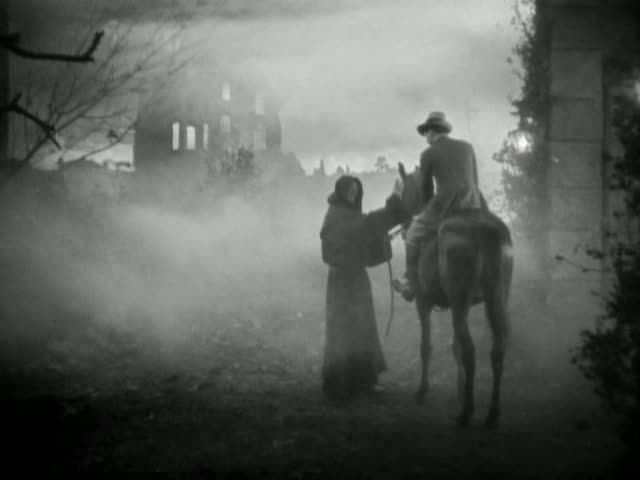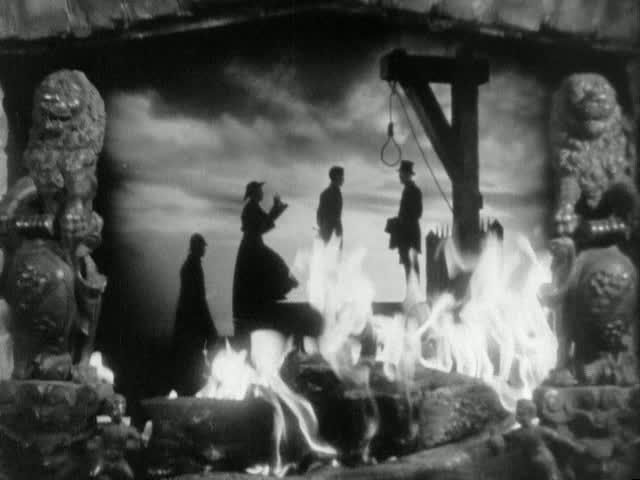

John Ford's Hangman's House is an overlooked expressionist classic from the director's silent era, a moody and evocative melodrama in which revenge, guilt and suppressed desire flow through the foggy Irish moors. It's a film that's swathed in fog, set in and around a creepy Gothic mansion that seems like it should be housing a 1930s Universal horror flick, populated with mad scientists and lurching monsters. Instead, it's the home of the bitter old hanging judge James O'Brien (Hobart Bosworth), who Ford introduces in a remarkable shot with the camera looking out from inside the old man's fireplace, the flames flickering up at both the aged, stooped judge and the proud portrait of him in his prime, hanging on the wall behind him. The fireplace stands in for Hell, its flames passing fiery judgment on the bitter old man's life, a life spent sending men to their deaths. He sees visions of the men he's hanged, acted out in silhouette dioramas within the flames, or the faces of the men and their families floating in the fire, summoning him to join them.
O'Brien, on his deathbed, ends his life with one last ugly act, forcing his daughter Conn (June Collyer) to marry the no-good John D'Arcy (Earle Foxe), rather than her longtime sweetheart Dermot (Larry Kent). The plot's a bit of a mess, actually, and the script rushes through the set-up so that any emotional motivations seem clipped and obscure. For that reason, it's hard to say why Conn's father pushes her off on D'Arcy, who he seems to think will give his daughter a successful life even though a title card comes right out and all but calls D'Arcy a sleazeball, or why she goes along with it so easily. In any event, she's soon trapped in a marriage to a man who goes out of his way to prove he's a villain: drinking, gambling, snitching, and in one horrifying scene, actually shooting his wife's beloved horse after it had won a race where he'd bet on another horse.
This Gothic melodrama is juxtaposed against the presence of the outlaw Citizen Hogan (future Ford regular Victor McLaglen in his second appearance for the director), who has returned to Ireland from a stint in the Foreign Legion in order to get revenge on D'Arcy for the scoundrel's treatment of Hogan's sister. Hogan, in the film's opening scene, gets as good an introduction as O'Brien does, receiving a telegram at the dinner table, apparently giving him the news about his sister's suicide. "I've got to kill a man," an intertitle reads, and then the camera tracks back woozily to the end of the table, as all the men toast to him, wishing him luck. Hogan is a cheery and exuberant spirit of vengeance, an exile from Ireland whose return makes him misty-eyed with nostalgia and a love for his home country, even as he sets out on his dark errand. In that he seems like a surrogate for the director, who's using this lurid story to express his own love for the country, to capture some of its romance in these expressionist landscapes. Hogan drifts through the fog in a series of near-comical disguises — a monk, a blind beggar — that never quite fool anyone, what with his hulking form and his infamous reputation. He's death come calling with a ready smile and a twinkle in his eye, a distinctly Irish Grim Reaper.


The film is visually sumptuous, with Ford liberally applying fog and shooting through a hazy soft focus to disguise the minimalist studio set and lend a dreamy atmosphere to the surroundings. There are several contemplative scenes set in the area around O'Brien's Gothic home, with the house's towers looming up through the fog, twisted trees erupting from the rocky soil, and colorful local characters appearing on the foggy paths. At one point, Conn and Dermot go to see Hogan, taking a boat ride through a beautifully eerie swamp, surrounded by reeds, the hazy fog swallowing up everything around them. The film's fuzzy aesthetic is enthralling throughout, paying tribute to Ford's German Expressionist influences and foreshadowing the continuation of that line of influence in the later Hollywood horror cycles.
When the film ventures out into the daylight, as it does for the central horse race, it remains compelling, capturing the traditions and activities of the Irish countryside. At the race, a very young John Wayne makes his first visible appearance onscreen, as an extra watching the race. But more importantly, the race is viscerally thrilling, much of it shot from below with the horses seeming to jump over the camera, and Ford's cutaways to an excited Hogan are charming. There's charm, too, in Conn's sweet romance with Dermot, which strangely enough continues unabated even after she marries another man, at least in part because Conn, who dresses in masculine, androgynous clothes, seems more interested in taking endless strolls through the fog than actual romance or sexuality.
The film ends by cycling back to the beginning's evocation of Hell in a fireplace, exploding in a fiery climax that lights up the night and at least temporarily clears the fog. It's a beautiful resolution, communicated entirely in hellish, harrowing images of the titular mansion being engulfed in flames, the fire making it look like a cathedral glowing in the darkness, giving it a bright stained glass quality, shimmering in the hazy night. Hangman's House is silent Ford at his best, taking a less-than-coherent melodrama and making it a moving ode to the director's beloved Ireland with a gorgeous visual style that channels and magnifies the story's potent emotions.

5 comments:
With a week off for spring break, and some catching up to do on the DVD front, I thought I'd address this review with a Tuesday morning viewing of the film. So I pulled my Ford at Fox Silent Epics box set containing HANGMAN'S HOUSE and four others off the shelf and just viewed this expressionist 71 minute early work, since it's one of two in the set I hadn't yet watched (with FOUR SONS)
Anyway, your superlative review typically captures the essence and artistic worth of this Germanic-styled film, one that uses atmospherics to impressive effect. Yes there is fog (and cigarette smoke) everywhere and the fireplace montage and hanging silhouettes bring visual distinction to what the narrative convolutions. Yes it is indeed sumptuous, Ford's love for his native Ireland has never been more evident, and the eerie set piece of the mansion is the background for the film's best scenes. The hellishness has a horror film feel (I see you mention this in your reference to the later cycles) and the fiery climax immediately brings Universal's FRANKENSTEIN to mind.
I absolutely buy your concluding judgement asserting that Ford's visual style here ultimately trumps the narrative shortcomings. Horse lovers of course will be grief-stricken.
Victor McLaglen shows part of that fiery charisma that reached fruition years later with films like THE INFORMER, and Tim Curran provides an atmospheric if atypical score composed for this Fox DVD version.
So glad you took the opportunity to watch this one, Sam. I really liked it, primarily for that gorgeous horror movie atmosphere, which easily trumps the undeniable limitations of the rather silly plot. I appreciate the B-movie economy of the plot and the emphasis on atmosphere. And yes, the horse scene was quite harsh.
Didn't the boat ride scene remind you a bit of Night of the Hunter? Very beautiful stuff.
McLaglen was a blast in this, mixing humor and anger really well, but I was also impressed by June Collyer, who's quite charming as the tomboyish heroine.
Four Sons is also good, by the way, probably Ford's most overt Murnau tribute.
Ah, THE NIGHT OF THE HUNTER is a terrific reference point for that boat ride sequence!
I'm gonna give FOUR SONS a go this afternoon in fact.
I saw this one for the first time recently too--it's a lot of fun, and while the expressionist touches are nice, it was all the horse race for me, which really took me by surprise.
Nice review.
Thanks, Peter. The horse race was really well-staged, and its aftermath is stunning.
Post a Comment